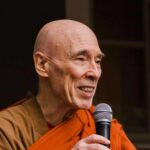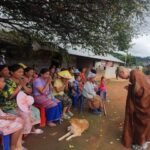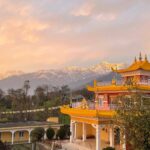At this particular conference, these two worlds came together through the organizational vision of the local WFB chapter and host, the Japan Buddhist Federation (JBF), and specifically through its two foreign deputies Rev. Yoshiharu Tomatsu and Rev. Shojun Okano. Rev. Tomatsu as well as Hsiang-chou Yo of Taiwan, who both sit on the WFB Executive Committee, have straddled the WFB and INEB worlds for a number of years. Along with Rev. Okano, they encouraged the JBF and the WFB to take stronger stance on social engagement, and in an encouraging sign, both groups readily accepted the agenda for this conference.
This agenda meant setting aside an entire day of the three day conference for symposia on seven different key social issues as well as an advance screening of Helena Norberg-Hodge’s filmThe Economics of Happiness. Norberg-Hodge describes the film as pointing “the way to a more satisfying and sustainable future through economic localization”, and “how this is a necessary antidote to globalization, which is dismantling communities worldwide.” But, as she notes, “this is not a gloom-and-doom film … Inspiring examples of grassroots initiatives, from a rural regeneration program in China to community-building projects in Detroit, show the enormous benefits-environmental, social, even spiritual-of bringing the economy closer to home.” After the 45 minute screening, Norberg-Hodge was joined on stage by two visionaries from the engaged Buddhist movement, Dr. A.T. Ariyaratne, the founder of the Sarvodaya Shramadana Movement in Sri Lanka, and deep-ecologist Joanna Macy from the United States. Reiko Yukawa, a Japanese entertainer who has become involved in social issues, also joined them, and all three offered their comments on the film.
This morning program effectively set the stage for the afternoon symposia, which were able to look more in depth at the many social issues and problems that Norbeg-Hodge’s film brought up. The seven chosen themes were: 1) peace and coexistence, 2) economics and development, 3) caring for the dying and bereaved, 4) gender, 5) suicide, 6) environment, and 7) youth. In the same spirit of Norberg-Hodge’s film of offering inspiring examples of grassroots initiatives, the 35 panelists and coordinators on these seven panels focused on real practices to overcome the many problems we face. Indeed, these panelists were chosen not for their academic backgrounds or intellectual acumen but for their actual engagement in the issues. And this is where the WFB and INEB worlds came together since a large proportion of the panelists came directly from the INEB network. Space does not provide an in depth discussion of these panels, but I will offer below a brief synopsis of each and an introduction of the panelists and the coordinators who are doing such meaningful work.
1) Peace and Coexistence
The panelists spoke directly about the activities they have been engaged in within the context of their own national conflicts (i.e. the conflict on the Korean Peninsula, the struggle for democracy in Burma, the ethnic war in Sri Lanka, and the preservation of anti-militarism in Japan). They used the Four Noble Truths (problem, cause, vision, action) as the basic structure for their discussion. They also sought to make clear the difference between a dharmic way of peace building without violence and the way of using force. Coordinator: Rev. Hitoshi Jin (Japan), Director of the Japan Buddhist Council on Youth and Child Education (Zenseikyo Foundation) and a Senior Research Fellow at the Rinbutsu-ken Institute for Engaged Buddhism in Tokyo. Panelists: Ven. Pomnyun Sunim (South Korea), founder of the Jungto (Pure Land) Society seeking to apply Buddhist teachings to the full range of modern ills from conflict and poverty to environmental degradation; A.T. Ariyaratne (Sri Lanka), the founder and President of the Sarvodaya Shramadana Movement in Sri Lanka, the world’s largest spiritually-based people’s development movement; Ashin Nayaka (Burma), Secretary of the International Burmese Monks Organization (IBMO), which advocates for peace and freedom in Burma. Rev. Shokyo Odake (Japan), Director of the Association for Nenbutsu Followers for Article 9 of the Japanese Constitution.
2) Social Development by Buddhists: What Can We Do?
Poverty, environment, human rights, and peace-even in the 21st century, these global issues caused by “development” are becoming more serious. When we look at the present global society, the richest 20 percent of the world’s people possess 84 percent of the wor
ld’s wealth, and 80 percent of the world’s people live in the developing world while 20 percent of those people live on less than one dollar a day. In Japan, the economic difference between urban cities and rural areas is continually widening and the people have lost sight of a healthy and prosperous life. In this panel, the panelists shared and discussed everyday activities, both spiritual and social, and investigated the way to proper social development towards a better future. Coordinator: Tatsuya Hata (Japan), former Executive Secretary and senior board member, and present Director of SVA – the Soto [Zen] Volunteer Association (now the Shanti Volunteer Association). Panelists: Karma Ura (Bhutan), the President of the Centre for Bhutan Studies, a non-aligned, objective, multi-disciplinary and autonomous social science research center focused on Gross National Happiness (GNH) and related indicators; Ven. Boonchuay Doojai (Thailand), Vice Rector of Mahachulalongkorn Buddhist University in Chiang Mai and General Secretary of the Buddhist Monk Network in Northern Thailand; Rev. Alan Hozan Senauke (USA), former Director and present Senior Advisor of the Buddhist Peace Fellowship and founder of the Clear View Project. Rev. Shunei Hakamata (Japan), co-founder of the Soto [Zen] chapter of the Vihara movement for terminal care and founder of the Thinking about Our Hearts and Lives Association, a suicide prevention group in Akita.
3) Buddhist Wisdom in Caring for the Dying and Bereaved
Confronting mortality poses challenges for terminal patients, their caretakers, and their survivors. Yet a wide range of spiritual needs are well-addressed by traditional Buddhism, and the efficacy of these practices is being increasingly documented by medical and social research- such as that meditation can reduce angst and depression among dying patients and caretakers; teachings can provide a rich vision assuaging concerns about the afterlife; and rituals can reduce and heal psychological traumas after bereavement. The panelists in this session gave concrete examples of these practices, and afterward had a rich discussion on the potential for using Buddhism in spiritual care for the dying. Coordinator: Carl Becker (USA/Japan), Professor at the Kyoto University Graduate School of Human and Environmental Studies and co-founder of the International Association for Near-Death Studies. Panelists: Rev. Joan Halifax (USA), founder of the Upaya Zen Center and Institute and the Project on Being with Dying; Dr./Rev. Kangen Shibata (Japan), medical doctor at Noshiro Hospital in Akita and head of the Nichiren Vihara Project for the dying; Dr. Chien-an Yao (Taiwan), Director of the Palliative Care Unit at the National University of Taiwan Hospital and member of the Clinical Buddhist Research Association; Ven. Phaisan Visalo (Thailand), Buddhika Network for Buddhism and Society which is developing a network of religious and medical professionals working for more integrated spiritual and physical care for the dying.
4) In Search of Gender Equality in Buddhism
The gender issue should be recognized as not only one important social issue, but also as an important issue within Buddhism itself. For example, there are problems of women’s ordination and after ordination especially in Theravada countries, and there is the unique problem of priests’ wives and family members living in the same temple in Japan. If the situation remains the same, Buddhism will not be able to live up to the needs and demands of women living in today’s world, who could benefit from Buddhism’s liberative teachings and practices. In this session, the panelists shared the voices of Buddhist women, which have been largely ignored by most Buddhists all over the world. In this way, they hoped to take one step towards creating a society in which women inhabit Buddhism without any barriers. Coordinator: Mika Edaki (Japan), former staff of SHARE Thailand, a non-governmental organization promoting HIV and AIDS awareness, and present coordinator of AYUS, a Buddhist based Japanese NGO for international cooperation. Panelists: Ven. Chao-hwei Shih (Taiwan), Dean of Hong-Shih Buddhist College, and the founder and Director of the Research Centre for Applied Ethics at Hsuan-Chuang University; Ven. Tsering Palmo (Ladakh, India), founder and President of the Ladakh Nuns Association, and the first Ladakh nun trained as a Tibetan Medical Doctor. Noriko Kawahashi (Japan), Professor of Religion at the Nagoya Institute of Technology and a member of the Tokai-Kanto Network for Women and Buddhism; Ouyporn Khuankaew (Thailand), founder and Director of the International Women’s Partnership for Peace and Justice (IWP).
5) What Can Buddhists Do about Suicide as a Social Problem?
The number of people who commit suicide has increased in contemporary society, especially Japanese society which has averaged over 30,000 suicides per year for the last ten years. The recognition is now spreading that the act of ending one’s own life is a major, structural social problem as well as a personal matter. The panelists discussed the practical activities of Buddhists who are actually engaged in this problem, the motivations that led to engaging in these activities, and also what can be learned from these opportunities of getting involved. Coordinator: Rev. Katsumi Fujisawa (Japan), co-founder of the Priests Tackling Suicide Problems. Panelists: Rev. Eichi Shinohara (Japan), consultant for the Soto [Zen] Human Rights and Education Bureau, and President of the suicide prevention network Kaz-e; Rev. Jotetsu Nemoto (Japan), founder of an internet community board offering a platform to exchange information on treatment and mutual support; David Brazier (UK), head of the Order of Amida Buddha who has also worked as a psychotherapist, psychodramatist, and psychiatric social worker. Udomsil Srisangnam (Thailand), Professor of Psychiatry and Deputy Dean in the Faculty of Medicine at Mahidol University, and Vice Chairman of the Thai Health Promotion F
oundation.
6) Youth in Buddhism
From India in Asia to the Western world, Buddhism has become the source of mental strength in the lifestyles of many people. The teachings of the Buddha on wisdom and compassion have a great influence in laying a foundation during the adolescent development process. Furthermore, the teachings also influence the future of the world. As we study the spread of Buddhism and its impact in the world, we should now explore the various ways Buddhism has contributed to human development and its roles in the realization of a peaceful and happy society. Coordinator: Anurut Vongvanij (Thailand), President of the World Fellowship of Buddhist Youth (WFBY) and Deputy Director of the World Buddhist University. Panelists: Ong See Yew (Malaysia), President of the Young Buddhist Association of Malaysia (YBAM) and course director and trainer for several Buddhist youth leadership development programs; Tempel Smith (USA), teaches Buddhist spirituality and meditation to teenagers and adults through the Buddhist Peace Fellowship, Spirit Rock Meditation Center, and Insight Meditation Society; Mangesh Dahiwale (India), staff of the Nagarjuna Institute and Nagaloka Training Center in Nagpur, which trains young Dalit Buddhists from all over India in Buddha Dhamma and community organizing skills; Rev. Daito Noda (Japan), founder of the Kappa Dojo Foundation, located in his temple where he runs a school for youth with behavioral disabilities and a program for young, mostly male, shut-ins.
7) A Buddhist Approach to Practical Solutions to the Environmental Crisis
Buddhists are often quick to point out the environmentally friendly nature of our teachings, but are slower to take concrete actions to confront the imminent environmental crisis. The participants on this panel all agree that the crisis is real and that time is running out. The time for mere theory is over, and now is the time for practical solutions. The panelists spoke passionately, based on their extensive experience, and offered practical solutions to our environmental crisis. Coordinator: Kenneth Tanaka (USA/Japan), Professor at Musashino University and President of the International Association of Shin Buddhist Studies. Panelists: Helena Norberg-Hodge (Sweden/UK), Director of the International Society for Ecology and Culture (ISEC); Rev. Hideto Okochi (Japan), co-founder of the Edogawa Citizen Network Concerned with Global Warming and the Mirai (Future) Bank. Joanna Macy (USA), Buddhist teacher, writer, and activist engaged in issues of environmental and social justice. Sorrayut Ratanapojnard (Thailand), faculty in the Department of Biology at Mahidol University and founding member and Manager of the New Consciousness Group.
A second coming together of worlds at this conference was the intersection of three domains in Japan: conservative Japanese Buddhist society, the emerging socially engaged Buddhist community, and the NGO and civil society communities of Japan. Buddhist countries like Thailand and Sri Lanka have very conservative monastic sanghas like Japan. However, through the pioneering work of progressive Buddhists in these countries, an important link has been made with progressive civil society and NGO organizations. This link has been slow to form in Japan where not only are the civil society and NGO sectors still quite immature, but Buddhism is almost always seen as a remnant of Japan’s feudal and militaristic past rather than as a resource for post-industrial social development.
At the seven symposia listed above, the coordinators and panelists from Japan represented a very important and new kind of civil society leader. They are either priests with a great knowledge of social issues who have become active in social development, or they are NGO workers who have taken a particular interest in the potentials of Buddhism to promote a new kind of holistic “dharmic” social development-a concept that is being promoted now in Japan askaihotsu. These individuals created a crucial bridge at the WFB meeting, because they were able to draw in Japanese who would normally stay away from such Buddhists meetings. At the same time, their Buddhist background and credentials created an opening to expose more conservative members of the Japanese monastic Sangha to how Buddhists can meaningfully engage in contemporary society. This is an agenda gaining increasing interest from denominational headquarters that are troubled by their declining memberships and dwindling social relevance.
Finally, the meeting of these three Japanese groups with the other panelists, who are leading activists in the international engaged Buddhist world, had what is hoped to be a transformative effect on Japan. Japan is a society rife with social ills, such as a moribund economy that is leading to increased abuses of human labor that in turn has led to high level of alienation, desperation, and suicide. It is a society that has lost its spiritual and ethical bearings. The public realm is secularized to the point that religion and religious institutions can play no meaningful role in it; and the privatized religious realm, especially Buddhism, is rife with an outdated and parasitic form of ritualized ancestor worship – a sort of contemporary Brahmanism. In this way, the connections made at the WFB meeting will hopefully: 1) offer marginalized Japanese engaged Buddhists a wider sangha of connections and relationship overseas that can help support both their inner and outer work; and 2) expose the highly secularized Japanese NGO community and the conservative Buddhist establishment to the potentials of spiritually engaged social development.
In this way, some of the best work and results of the conference were in the days leading up to and following the conference. The WFB only allotted one day for interaction with this incredible group of 35 coordinators and panelists. However, the Japanese coordinators tapped into their local networks and set up a wide variety of activities with the panelists in the days surrounding the meeting. For example, Ven. Tsering Palmo led a three day workshop on Tibetan medicine and healing at the temple of the leading WFB and JBF host, Rev. Yoshiharu Tomatsu. Mika Edaki set up a series of workshops for Ouyporn Khuankaew with groups like the Development Education Association and Resource Center (DEAR) as well as the Tokai-Kanto Network for Women and Buddhism. Hitoshi Jin assisted Dr. Ariyaratne in setting up a public event which led to the formation of Sarvodaya Japan.
Rev. Jin also organized from his Rinbutsu-ken Institute for Engaged Buddhism a symposium at Tokyo University the day after the end of the WFB meeting on the theme “Interbeing: Environment, Peace, and Socio-Spiritual Development.” This was a major public event specifically aimed at the more secular academic and NGO Japanese communities. Dr. Ariyaratne, Helena Norberg-Hodge, Joanna Macy and Ven. Phaisan Visalo (also a renowned development monk) were the main speakers. While all four of them are perhaps better known amongst academic and NGO groups than among Buddhist groups in Japan, it was an unprecedented coming together of leading engaged Buddhist visionaries to speak on these issues.
Finally, there was also a three-day workshop by Joanna Macy on her despair and empowerment work called Coming Back to Life. This was organized by the Engaged Buddhism Research Group, AYUS, the Zenseikyo Foundation, DEAR, and the Web of Life. This workshop provided a particularly intense and meaningful interaction for Japanese engaged Buddhists and other NGO and civil society groups. Not only did some of the Japanese coordinators and panelists from the WFB meeting participate but so did some of the international panelists as well. Through this latter group and through the inspiring instruction of Macy, both Japanese Buddhists and non-Buddhists could gain a clear insight into how Buddhism can be an integral part of building a post-industrial society; one that is imbued with an accessible and egalitarian form of dharma rather than an elitist, nationalistic, and patriarchal form of Buddhism.
It is still too early to fully evaluate the results of this conference. Indeed, there are very few conferences that actually create any kind of shift in people’s attitudes and practices. The questions that existed coming into the conference still remain, though I would like to offer here a few early answers to them.
- Will the WFB actually use its incredible material and financial resources to do something meaningful in society while spending less money on their own meetings? There are some encouraging signs as WFB has presently begun to develop a social action and service component to their federation.
- Will INEB ever amount to anything more than a motley association of very small engaged Buddhist groups and individuals? There are encouraging signs here as well with the reconstruction of the INEB’s Executive and Advisory Committees, which we may be able to evaluate at their large 20th annual conference next November in Chiang Mai, Thailand.
- Will Japanese society be able to overcome the private religious/public secular split which is deeply debilitating to both sides? The one major reservation to the accomplishments of the WFB conference was the exclusion of the large and important new Buddhist denominations in Japan, like Soka Gakkai and Rishho Koseikai and others. The Soka Gakkai is a unique case, because they themselves explicitly do not work with any other religious groups in Japan (while hypocritically campaigning for world peace and religious dialogue abroad). Unfortunately, the Japan Buddhist Federation has a policy of not including any of the many other new Buddhist organizations, some of which are important partners with the socially engaged Buddhist groups mentioned above and with various NGO and civil society groups. The JBF policy is largely a superficial one in that in practice there is significant cooperative work among all Buddhist denominations in Japan, with the exception of Soka Gakkai. However, the fact that these new Buddhist denominations could not participate in the WFB meeting was a significant loss and missed opportunity for building stronger ties.
As someone who has endeavored to network together engaged Buddhists in Japan since 1993, I have often not felt very optimistic about developments here. However, in just the least few years, there are new and very encouraging signs that we could be headed in the right direction. The very fact that the WFB meeting could be held in Japan, create and realize the agenda of the seven symposia and the film, and on top of this, that numerous major and minor activities were created outside of the confines of the conference by interested individuals from both sides of the religious/secular split shows that Japan might indeed be moving in the right direction.
?
Jonathan Watts is a Research Fellow at the International Buddhist Exchange Center (IBEC) in Yokohama (under Rev. Shojun Okano) and at the Jodo Shu Research Institute in Tokyo (under Rev. Yoshiharu Tomatsu). He assisted both of them in arranging the seven symposia and the film at the WFB conference. He also serves on the Executive Committee of the International Network of Engaged Buddhists (INEB).
————————————–
 From SEEDS OF PEACE : Vol.25 No.1 Jan.-Apr.2552(2009)
From SEEDS OF PEACE : Vol.25 No.1 Jan.-Apr.2552(2009)
Faith and Spirituality in Dark Times
?










